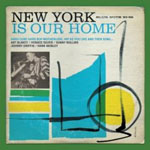Home » Jazz Articles » Album Review » Various Artists: New York Is Our Home
Various Artists: New York Is Our Home
Hard bop was at the apex of African-American culture from 1955 to around 1965, when rock and soul drove it from the throne. By the time it declined, the music was heavily, often excessively codified. Between 1954-57, however, when most of the tracks on New York Is Our Home were recorded, everything was still to play for. Horace Silver may be the pianist on ten of these tracks, and Art Blakey the drummer on eight, but the only thing that runs through all of them is African-centric energy, as received through blues and gospel. Beyond that, individual expression is key.
The album includes a few acknowledged benchmark cuts—notably Silver's "Doodlin," from 1954, and The Jazz Messengers' "Avilla and Tequila," from 1955, both of which, alongside trumpeter Miles Davis' title track from Walkin' (Prestige, 1954), are generally considered to be early paradigms of the music. But none of hard bop's later, warhorse albums have been sampled, and New York Is Our Home does the legacy a favor by its inclusion of less widely celebrated recordings.
Of these latter tracks, pianist Elmo Hope's "Abdullah," from Elmo Hope Quintet (Blue Note, 1953)—a rough diamond thrillingly showcasing Hope's blues drenched style with its percussive, left-hand, single-note punctuation marks—is the most remarkable. But tenor saxophonists Clifford Jordan and John Gilmore's "Blue Lights," from Blowing In From Chicago (Blue Note, 1957)—an unadorned but engaging, brisk blues—and guitarist Kenny Burrell's sinuous "Caravan," from Blue Lights Vol.2 (Blue Note, 1958), are also very welcome.
It's worth noting in passing that while New York, as the album title attests, may have been the home of hard bop, it was for its musicians an adopted home. Of the nineteen bandleaders featured on New York Is Our Home, only three—saxophonist Sonny Rollins and pianists Elmo Hope and Bud Powell—were born in the city. In the mid-1950s, you could make it in other places, but until you'd made it in NYC you hadn't truly arrived.
Track Listing
CD1: Avilla and Tequila (The Jazz Messengers); Minor's Holiday (Kenny Dorham); Caravan (Kenny Burrell); News for Lulu (Sonny Clark); City Lights (Lee Morgan); The Outlaw (Horace Silver); Misterioso (Sonny Rollins); Blue Lights (Clifford Jordan and John Gilmore); We Six (Paul Chambers); Don't Walk (Hank Mobley). CD2: Doodlin (Horace Silver); Gaza Strip (Lee Morgan); Abdullah (Elmo Hope); Buster Rides Again (Bud Powell); The Congregation (Johnny Griffin); Zec (Thad Jones); Algonquin (Curtis Fuller); Ande (Louis Smith); Wee Jay (J.R. Monterose); Coffee Pot (Jay Jay Johnson).
Personnel
Various Artists
variousBands led by Art Blakey, Kenny Dorham, Kenny Burrell, Sonny Clark, Lee Morgan, Horace Silver, Sonny Rollins, Clifford Jordan and John Gilmore, Paul Chambers, Hank Mobley, Elmo Hope, Bud Powell, Johnny Griffin, Thad Jones, Curtis Fuller, Louis Smith, J.R. Monterose, Jay Jay Johnson.
Album information
Title: New York Is Our Home | Year Released: 2008 | Record Label: Blue Note Records
< Previous
Stratostrophic
Next >
It's Happenin'
Comments
About Various Artists
Instrument: Various
Related Articles | Concerts | Albums | Photos | Similar ToTags
Concerts
For the Love of Jazz
 All About Jazz has been a pillar of jazz since 1995, championing it as an art form and, more importantly, supporting the musicians who create it. Our enduring commitment has made "AAJ" one of the most culturally important websites of its kind, read by hundreds of thousands of fans, musicians and industry figures every month.
All About Jazz has been a pillar of jazz since 1995, championing it as an art form and, more importantly, supporting the musicians who create it. Our enduring commitment has made "AAJ" one of the most culturally important websites of its kind, read by hundreds of thousands of fans, musicians and industry figures every month.





















